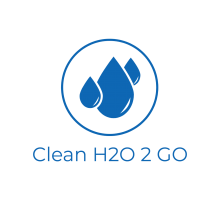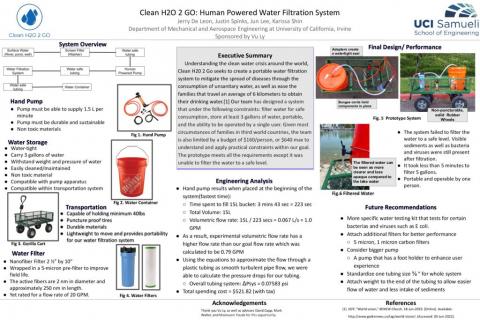Portable Water Filtration System (human power)
We are team Clean H2O 2 GO and we are designing a water filtration system that can be operatated and powered by one person.
Background
In developing countries more than 884 million people suffer from unsanitary water. The World Health Organization(WHO) published that people do not have access to safe drinking water in 2017, causing diseases such as cholera, dysentery, and polio. To mitigate the spread of these diseases and to provide clean water to these communities the overall objective is to build an affordable, portable, and sustainable water filtration system.
Goals and Objectives
- Purify raw river water to drinkable water
- Be able to produce/store enough water for 4 people for one day
- Human powered, operable by one person
- Portable
- Water capacity should be able to hold a minimum of 10 liters of water
- Low maintenance and cost for the overall project design
- Easy to use and operate
- Flow rate of water dispensed should be fast enough where it should take at least 5-10 minutes to fill to max capacity
Key Main Components
- Hand vacuum pump: A vacuum pump is a convenient and effective water transfer device.
- Tubing: The components of the system are connected by water safe tubing.
- Filters: A nano-filter captures viruses and bacteria, while two 1 micron activated carbon filters capture heavier sediments and improve the quality of the water.
- Water container: a 5 gallon bucket, modified to connect to the system and to dispense water through a spigot.
- Four wheel cart: Rubber wheels to be unpoppable, holds all components, and easy to transport.
Requirements
Water Filtration System
- Capable of filtering particles, bacteria, and viruses larger than .02 microns in diameter
- Handle a maximum flow rate of 0.4 GPM, to keep the filtration process under 10 minutes.
- Filters at least 30 gallons before becoming ineffective, for 12L or 3 gallons a day for a family will ensure at least a week of water per filter.
Pump
- Can supply a flow rate of at least .4 GPM.
- The time to fill up the required amount of water should be less than 5-10 minutes.
- Must be human powered.
Water Container
- Hold at least 12L or 3 Gallons of fluid, enough to satiate a family of four in daily water requirements.[1],[2]
Transportation
- Capable of holding 60lbs., the combined weight of 3 gallons, the pump, and water filter with a factor of safety of 2.
- Must have a clearance of 8 inches, to allow for uneven terrain, mud, and gravel.
- This system must be only require 20 lbs. of force to transport.
Budget
- Overall budget cost should not exceed $640
Challenges
The challenges of this project is the compatibility of the components. For example, the sizing of the tubing that fits into the pump and water container. Also, the dimensions of the filters we buy to properly fit into our design. Filtering bacteria and viruses without the use of electricity, such as UV or boiling/vaporizing. We also have to take into account the flow rate of water being produced from the hand pump to minimize time spent. We aim to optimize the time spent on gathering water and the total cost of producing the product to help better the communities for developing countries.
Team Contacts
- Jun Lee: junwool@uci.edu
- Justin Spinks: jspinks@uci.edu
- Alex Munoz: alexm6@uci.edu
- Karissa Shin: karissss@uci.edu
- Jerry De Leon: jddeleon@uci.edu
Midterm Presentation
Final Presentation
Team Advisor
- Vu Ly: qvly@uci.edu
Team Contract
Link to our Team Contract
References
[1] J. Rethy, “Choose water for healthy hydration,” HealthyChildren.org. [Online]. Available: https://www.healthychildren.org/English/healthy- living/nutrition/Pages/Choose-Water-for-Healthy-Hydration. [Accessed: 09-Jun-2022].
[2] Mayo Clinic Staff, “How much water do you need to stay healthy?,” Mayo Clinic, 14-Oct-2020. [Online]. Available: https://www.mayoclinic.org/healthy-lifestyle/nutrition-and-healthy-eatin.... [Accessed: 09-Jun-2022].


